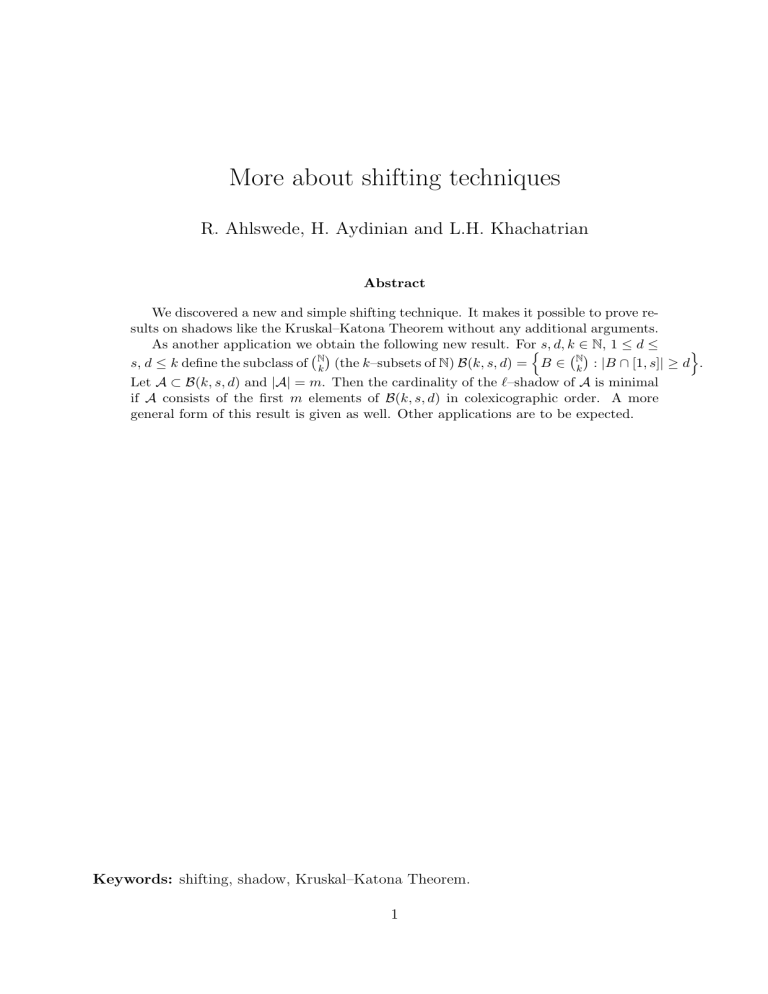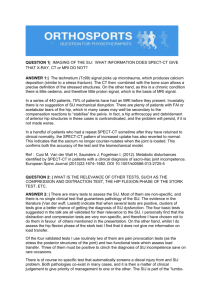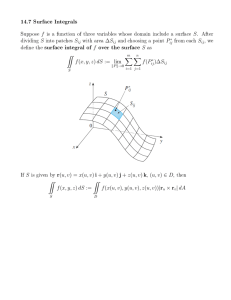More about shifting techniques
advertisement

More about shifting techniques
R. Ahlswede, H. Aydinian and L.H. Khachatrian
Abstract
We discovered a new and simple shifting technique. It makes it possible to prove results on shadows like the Kruskal–Katona Theorem without any additional arguments.
As another application we obtain the following new result. Forns, d, k ∈ N, 1 ≤ d ≤
o
¡ ¢
¡ ¢
s, d ≤ k define the subclass of Nk (the k–subsets of N) B(k, s, d) = B ∈ Nk : |B ∩ [1, s]| ≥ d .
Let A ⊂ B(k, s, d) and |A| = m. Then the cardinality of the ℓ–shadow of A is minimal
if A consists of the first m elements of B(k, s, d) in colexicographic order. A more
general form of this result is given as well. Other applications are to be expected.
Keywords: shifting, shadow, Kruskal–Katona Theorem.
1
1
Introduction
N denotes the set of positive integers and the set {1, . . . , n} is abbreviated as [n]. Given
k ∈ N and X ⊂ N we denote
µ ¶
©
ª X
X
2 = F :F ⊂X ,
= {F ⊂ X : |F | = k}.
k
Recall the well known exchange or shifting operation Sij which was introduced by Erdős,
Ko and Rado [2]. For a family B ⊂ 2[n] and B ∈ B set
(
¡
¢
¡
¢
{i} ∪ B r {j} , if i ∈
/ B, j ∈ B, {i} ∪ B r {j} ∈
/ B,
Sij (B) =
B,
otherwise
©
ª
Sij (B) = Sij (B) : B ∈ B .
Although the shifting operation was introduced in [2] to prove intersection theorems, it
turned out to be a powerful tool to obtain many other important results in Extremal Set
Theory. An excellent survey on it is given by Frankl [3].
Later on we will distinguish between left shifting, if i < j, and right shifting, if i > j.
We say that B is left shifted (right shifted) if Sij (B) = B for all 1 ≤ i < j ≤ n (for all
1 ≤ j < i).
We also say that B is left shifted with respect to an element u ∈ [n] if Siu (B) = B for all
1 ≤ i < u.
The following simple properties of the shifting operation are well known (see e.g. [3]).
Proposition.
(i) |Sij (B)| = |B|
¡ ¢
can be brought to a left shifted (right shifted) family by repeatedly
(ii) Any family B ⊂ [n]
k
applying left (right) shifts.
¡ ¢
For any 1 ≤ ℓ ≤ k the ℓ–shadow of a family A ⊂ Xk is defined by
ª
©
¡ ¢
∂ℓ (A) = F ∈ Xℓ : ∃A ∈ A : F ⊂ A .
¡ ¢
Define the colexicographic (colex) order for the elements A, B ∈ Nk as follows:
¡
¢
A ≺ B ⇔ max (A r B) ∪ (B r A) ∈ B, where the operation “max” is taken in the natural
order on N.
¡ ¢
We denote by L(k, m) the initial m members of Nk in the colex order.
The well–known Kruskal–Katona Theorem was discovered in 1963 by Kruskal [5], in 1966
by Katona [4], and in 1967 by Lindström and Zetterström [6].
¡ ¢
Theorem KK (Kruskal–Katona). Let A ⊂ Nk , |A| = m, then
¡
¢
|∂ℓ (A)| ≥ |∂ℓ L(k, m) |.
2
Let us mention the following important property of the shifting operation (see [3]).
¡
¢
¡
¢
¡
¢
¡ ¢
,
then
∂
S
(B)
⊆
S
∂
(B)
,
i.e.
|∂
S
(B)
| ≤ |∂ℓ (B)|.
Lemma 1.1. Let B ⊂ [n]
ℓ
ij
ij
ℓ
ℓ
ij
k
There is an elegant proof of Theorem KK due to Frankl [3] where Lemma 1.1, induction (on
m and k), and the cascade representation of m are used. (For a short proof see also Daykin
[1]).
In this paper we introduce a new shifting operation which makes it possible to prove results
like Theorem KK using ¡only
¢ shifting and nothing in addition. In particular we prove that
any finite family A ⊂ Nk can be brought to L(k, |A|) (applying the new shifting) with
nonincreasing size of its shadow.
2
The main tool: new shifting
For B ⊂
¡N¢
k
and u ∈ N define the families
Bu = {B ∈ B : u ∈ B}, Bū = B r Bu .
We introduce
an operation which we call right–left shifting (RL–shifting). Given a
¢
¡[n]now
family A ⊂ k and integers 1 ≤ j ≤ i < u the RL–shift Sij|u (A) consists of two parts
P1. First we apply the right shift Sij to Au .
P2. Next we apply iteratively left shifts Sru , r = 1, . . . , u − 1, to the family Sij (Au ) ∪ Aū .
More formally one can write
¡
¡
¢ ¢
Sij|u (A) , Su−1u . . . S2u S1u (Sij (Au ) ∪ Aū ) . . . .
The idea behind this operation is to get from family A a family with fewer sets containing
u. Whereas in part P1 “place is made at the left” for replacements of u in part P2 the left
shifting of u is actually done.
S
A, then Au = ∅ and Sij|u (A) = A. In this case the RL–shift Sij|u leaves A
Clearly if u ∈
/
A∈A
unchanged. It is important that we included RL–shifts with i = j. Here for every 1 ≤ i < u
Sii|u makes¡ no changes
on¢a considered
A in part P1. However, in part P2 A is transformed
¡
¢
into Su−1u . . . S2u S1u (A) . . . , left shifted with respect to u. With such operations we can
obtain a left shifted family.
¡ ¢
S
A let RLu (A) be the set of all families which can be obtained
and u ∈
Given A ⊂ [n]
k
A∈A
from A by iteratively applying RL–shifts Sij|u . Then we say that A is RLu –stable if for
every A′ ∈ RLu (A) we have |A′u | = |Au | (equivalently Aū′ = Aū ).
S
A.
We also say that A is RL–stable if A is RLu –stable for all u ∈
A∈A
Lemma 2.1. Suppose a family A ⊂
¡[n]¢
k
with |A| = m is RL–stable, then A = L(k, m).
3
Proof: Note first that A is left shifted, since in particular we have for all 1 ≤ r < u ≤ n
and any 1 ≤ i < u Sru (A) = Sii|u (A) = A.
Let A = {a1 , . . . , ak } ∈ A, a1 < · · · < ak . Given element at ∈ A with t < at observe that the
RLat –stability implies that A contains the set {at − t, . . . , at − 1, at+1 , . . . , ak }. Hence by left
shiftedness A contains all sets B = {b1 , . . . , bk } ≺ A with bt < at , bt+1 = at+1 , . . . , bk = ak .
For at = t this is obvious since there is no such¡ B.¢ Since A is RLat –stable for all at ,
which precedes A in the colex order.
t = 1, . . . , k we infer that A contains every set B ∈ [n]
k
¤
¡ ¢
can be brought to an RL–stable family, i.e. to L(k, |A|),
Lemma 2.2. Any family A ⊂ [n]
k
by repeatedly applying RL–shifts.
¡ ¢
Proof: Let S
A ⊂ Nk be a finite family with |A| = m and let r(A) denote the maximal
A. Also let A be already left shifted. We apply now an RL–shift Sij|r0
element of
A∈A
with r0 , r(A). Clearly for the resulting family A′ = Sij|r0 (A) with r1 , r(A′ ) we have
r0 − 1 ≤ r1 ≤ r0 . We consider two cases.
(i) |A′r0 | < |Ar0 |. In this case we apply left shifts to A′ reducing it to a left shifted family.
(ii) |A′r0 | = |Ar0 | (correspondingly r0 = r1 and Ar̄0 = A′r̄1 ). By definition of the RL–shift
A′ is left shifted with respect to the element r1 . Moreover A′r̄1 is left–shifted since Ar̄0
is left shifted.
Thus in both cases w.l.o.g. we may assume that A′ is left shifted with respect to r1 , and Ar̄′ 1
is left shifted. However note that A′ is not necessarily a left shifted family. Next we apply
an RL–shift Sij|r1 (A′ ) for some 1 ≤ j < i < r1 transforming A′ to a new family A′′ which is
left shifted with respect to the biggest element r2 , r(A′′ ) ≤ r1 and A′′r̄2 is left shifted, etc.
The described procedure cannot be continued indefinitely. After finitely many RL–shifts we
will come to a family A∗ with a biggest element r such that r cannot be decreased anymore
by RL–shifts. Since each RL–shift Sij|r does not increase |A∗r | (which is lower bounded) we
finally end up with an RLr –stable family B. Note that this with¡ the ¢left shiftedness of Br̄
. Further we repeat
implies (as we observed in the proof of Lemma 2.1) that Br̄ = [r−1]
k
the described procedure, applying now RL–shifts Sij|r−1 and assuming that B is left shifted.
Note that since Sij|u (Br̄ ) = Br̄µfor all 1 ≤ j ≤¶i < u ≤ n we may proceed only for Br applying
S
B r {r} . Continuing this procedure we finally obtain
RL–shifts Sij|u for u = max
B∈Br
an RL–stable family F, or equivalently F = L(k, |A|).
3
Shadows and RL–shifting
In addition to Lemma 1.1 for shadows we have the following property of shifting.
4
¤
¡ ¢
Lemma 3.1. Let A ⊂ Nk be left shifted with respect to element u, (i.e. Siu (A) = A for all
1 ≤ i < u) then for any 1 ≤ j < i < u one has
¡
¢
|∂ℓ Sij (Au ) ∪ Aū | ≤ |∂ℓ (A)|.
(3.1)
Proof: We have
∂ℓ (A) = ∂ℓ (Au ) ∪ ∂ℓ (Aū ).
(3.2)
We can assume that Au , Aū 6= ∅, since if Au = ∅ (3.1) is trivial and if Aū = ∅ we apply
Lemma 1.1.
.
Let us denote B = ∂ℓ (Au ). Then we can write B = Bu ∪ Bū (Bu ∩ Bū = ∅).
For a set A ∈ Au let 1 ≤ s¡< u be an element
/ A. Since A is left shifted with
¢ such that s ∈
respect to u we have A′ , (A r {u}) ∪ {s} ∈ Aū .
Therefore A r {u} = ¡A′ r {s} which
that for
¢ implies
¡
¢ any ℓ–subset (ℓ–shadow) E ⊂ A with
′
u∈
/ E one has E ∈ ∂ℓ {A r {s}} = ∂ℓ {A r {u}} ⊂ ∂ℓ (Aū ).
This implies that Bū ⊂ ∂ℓ (Aū ) and hence with (3.2) and the definition of B
.
∂ℓ (A) = Bu ∪ ∂ℓ (Aū ).
(3.3)
¡
¢
Consider now a right shift Sij (Au ) for some 1 ≤ j < i < u, and denote D = ∂ℓ Sij (Au ) .
We have
¡
¢
¡
¢
.
∂ℓ Sij (Au ) ∪ Aū = ∂ℓ Sij (Au ) ∪ ∂ℓ (Aū ) = D ∪ ∂ℓ (Aū ) = (Du ∪ Dū ) ∪ ∂ℓ (Aū ).
(3.4)
Thus Dū ⊂ ∂ℓ (Aū ) and with (3.4)
¡
¢
.
∂ℓ Sij (Au ) ∪ Aū = Du ∪ ∂ℓ (Aū ).
(3.5)
¡
¢
Suppose now B ∈ Au so that j ∈ B and i ∈
/ B. Then clearly B ′ , (B r {u}) ∪ {i} ∈ Aū
and B ′ r {j} = Sij (B) r {u}. This implies that for any ℓ–subset F ⊂ Sij (B) with u ∈
/ F we
have
¡
¢
¡
¢
F ∈ ∂ℓ {B ′ r {j}} = ∂ℓ {Sij (B) r {u}} ⊂ ∂ℓ (Aū ).
¡
Further by (3.3) |∂ℓ (A)| = |Bu | + |∂ℓ (Aū )|, and by (3.5) |∂ℓ Sij (Au ) ∪ Aū )| = |Du | + |∂ℓ (Aū )|.
But |Du | ≤ |Bu | by Lemma 1.1, which completes the proof.
¤
Clearly Lemmas 3.1 and 1.1 imply
¡ ¢
is left shifted with respect to element u, then for any
Lemma 3.2. Suppose A ⊂ [n]
k
1 ≤ j < i < u one has
¡
¢
|∂ℓ Sij|u (A) | ≤ |∂ℓ (A)|.
¤
5
4
A proof of an improved Kruskal–Katona Theorem
¡ ¢
Theorem 4.1. Any family A ⊂ Nk with |A| = m can be brought by RL–shifts (with
monotonically decreasing size of the ℓ–shadow in each step) to the initial segment of size m
in the colex order.
Proof: To prove the theorem we just note that at each step of the procedure described in
the proof of Lemma 2.2 we apply an RL–shift Sij|u to a family which is left–shifted with
respect to the element u. This with Lemma 3.2 gives the result.
¤
5
A new result
¡ ¢
For s, d, k ∈ N, 1 ≤ d ≤ s, d ≤ k define the following subclass of Nk :
¾
½
µ ¶
N
: |B ∩ [1, s]| ≥ d .
B(k, s, d) = B ⊂
k
Denote by Lm B(k, s, d) the first m elements of B(k, s, d) in the colex order.
Theorem 5.1. Let A ⊂ B(k, s, d) with |A| = m, then for ℓ ≤ k
¡
¢
|∂ℓ (A)| ≥ |∂ℓ Lm B(k, s, d) |.
Proof: We may assume again that A is left shifted. We want to show now that applying
certain type of RL–shifts A can be brought to the initial segment of B(k, s, d) in the colex
order.
Note first that if |A ∩ [1, s]| > d for all A ∈ A we can apply RL–shifts proceeding as in the
proof of Lemma 2.2. Thus suppose there exists an A ∈ A with |A ∩ [1, s]| = d. We apply
now only RL–shifts of type
¡
¢
RL1: Sij|u (A) for any 1 ≤ j ≤ i ≤ s and i, j < u ≤ r r = r(A) ,
RL2: Sij|u (A) for any s + 1 ≤ j ≤ i < u ≤ r.
Note that the obtained families are still in B(k, s, d).
Using the same arguments as in the proof of Lemma 2.2 we infer that A can be brought to
an RL–stable family with nonincreasing size of the shadow. Note that the stability here is
defined with respect to RL–shifts of type RL1 or RL2. But now we can easily see that A is
nothing else but the first m members of B(k, s, d) in the colex order. This is clear because the
RL–stability with respect to RL1 and RL2 implies that if A ∈ A, B ≺ A and B ∈ B(k, s, d)
then B ∈ A.
¤
One can prove a more general statement using the same approach.
Let N = [1, s1 ] ∪ [s1 + 1, s2 ] ∪ · · · ∪ [st−1 + 1, st ] ∪ {st + 1, . . . , }, d1 ≤ d2 ≤ · · · ≤ dt ≤ k,
di ≤ si (i = 1, . . . , t).
6
Define
¾
½
µ ¶
N
: |B ∩ [1, si ]| ≥ di , i = 1, . . . , t .
B= B∈
k
Let also Lm B be the first m elements of B in the colex order.
Theorem 5.2. Let A ⊂ B and |A| = m, then
|∂ℓ (A)| ≥ |∂ℓ (Lm B)|.
References
[1 ] D.E. Daykin, A simple proof of the Kruskal–Katona Theorem, J. Comb. Theory (A)
17, 252–253, 1974.
[2 ] P. Erdős, C. Ko and R. Rado, Intersection theorems for systems of finite sets, Quart.
J. Math. Oxford 12, 313–320, 1961.
[3 ] P. Frankl, The shifting technique in extremal set theory, in: Surveys in Combinatorics,
Lond. Math. Soc. Lect. Note Ser., 123, 81–110, 1987.
[4 ] G. Katona, A theorem of finite sets, in: Proceedings of Tihany Conference, 1966,
187–207, Budapest 1968.
[5 ] J. Kruskal, The number of simplices in a complex, in: Mathematical Optimization
Techniques, 251–278, Berkeley–Los Angeles, Univ. of California Press, 1963.
[6 ] B.A. Lindström and M.O. Zetterström, A combinatorial problem in the K–adic number systems, Proc. Amer. Math. Soc. 18, 166–170, 1967.
7





